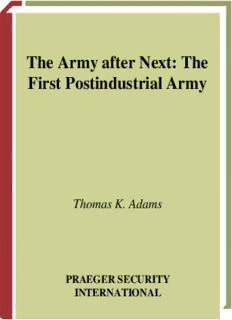
The Army after Next: The First Postindustrial Army PDF
Preview The Army after Next: The First Postindustrial Army
The Army after Next: The First Postindustrial Army Thomas K. Adams PRAEGER SECURITY INTERNATIONAL T A N HE RMY AFTER EXT PraegerSecurityInternationalAdvisoryBoard BoardCochairs LochK.Johnson,RegentsProfessor ofPublicandInternationalAffairs,Schoolof PublicandInternationalAffairs,UniversityofGeorgia(U.S.A.) PaulWilkinson,ProfessorofInternationalRelationsandChairmanoftheAdvisory Board,CentrefortheStudyofTerrorismandPoliticalViolence,UniversityofSt. Andrews(U.K.) Members EliotA.Cohen,RobertE.OsgoodProfessorofStrategicStudiesandDirector,Philip MerrillCenterforStrategicStudies,PaulH.NitzeSchoolofAdvancedInternational Studies,TheJohnsHopkinsUniversity(U.S.A.) Anthony H. Cordesman, Arleigh A.Burke Chair inStrategy, CenterforStrategic andInternationalStudies(U.S.A.) The´re`se Delpech, Senior Research Fellow, CERI (Atomic Energy Commission), Paris(France) Sir MichaelHoward,formerProfessor ofHistory ofWar, OxfordUniversity,and ProfessorofMilitaryandNavalHistory,YaleUniversity(U.K.) LieutenantGeneralClaudiaJ.Kennedy,USA(Ret.),formerDeputyChiefofStaff forIntelligence,Headquarters,DepartmentoftheArmy(U.S.A.) Paul M. Kennedy, J. Richardson Dilworth Professor of History and Director, InternationalSecurityStudies,YaleUniversity(U.S.A.) Robert J. O’Neill, former Chichele Professor of the History of War, All Souls College,OxfordUniversity(Australia) Shibley Telhami, AnwarSadat Chairfor Peaceand Development,Department of GovernmentandPolitics,UniversityofMaryland(U.S.A.) JusufWanandi,co-founderandmember,BoardofTrustees,CentreforStrategicand InternationalStudies(Indonesia) FareedZakaria,Editor,NewsweekInternational(U.S.A.) T A N HE RMY AFTER EXT The First Postindustrial Army Thomas K. Adams PRAEGERSECURITYINTERNATIONAL Westport,Connecticut (cid:127) London LibraryofCongressCataloging-in-PublicationData Adams,ThomasK. TheArmyafternext:thefirstpostindustrialarmy/ThomasK.Adams. p.cm. Includesbibliographicalreferencesandindex. ISBN0–275–98107–X(alk.paper) 1. UnitedStates.Army—Reorganization—History—21stcentury.2. UnitedStates.Army— Reorganization—History—20thcentury.3. UnitedStates—Militarypolicy.4. Militarydoctrine— UnitedStates—History—20thcentury.5. Militarydoctrine—UnitedStates—History—21stcentury. I. Title. UA25.A672006 355.30973—dc22 2006021062 BritishLibraryCataloguinginPublicationDataisavailable. Copyright©2006byThomasK.Adams Allrightsreserved.Noportionofthisbookmaybe reproduced,byanyprocessortechnique,withoutthe expresswrittenconsentofthepublisher. LibraryofCongressCatalogCardNumber:2006021062 ISBN:0–275–98107–X Firstpublishedin2006 PraegerSecurityInternational,88PostRoadWest,Westport,CT06881 AnimprintofGreenwoodPublishingGroup,Inc. www.praeger.com PrintedintheUnitedStatesofAmerica Thepaperusedinthisbookcomplieswiththe PermanentPaperStandardissuedbytheNational InformationStandardsOrganization(Z39.48-1984). 10987654321 C ONTENTS Chapter1 1 Introduction Chapter2 11 TheRootsoftheRevolution Chapter3 34 TheInformationArmy Chapter4 55 VisionandTransformation Chapter5 80 AnArmyTransformed Chapter6 102 TheDigitalArmyatWar Chapter7 132 TheWarwithIraq Chapter8 157 Aftermath Chapter9 181 TheNextArmy Chapter10 207 TheDigitalArmy vi Contents Chapter11 227 TheRealArmyafterNext Appendix:Pre-reorganizationStructureoftheU.S.Army 251 Notes 257 Glossary 297 SelectedBibliography 301 Index 321 Itwillbeenoughforme,however,ifthesewordsofminearejudgedusefulbythosewho want to understand clearly the events that happened in the past and which, human nature being what it is, will at some time or other and in much the same ways, be repeatedinthefuture. —Thucydides,HistoryofthePeloponnesianWar 1 CHAPTER I NTRODUCTION TheArmyhasnowishtoscrapitspreviousexperienceinfavorofunprovendoctrine,or inordertoaccommodateenthusiastictheoristshavinglittleornoresponsibilityforthe consequencesoffollowingthecoursesofactiontheyadvocate.WhiletheArmyisadapting itselfreadilytotheemploymentofnewweaponsandnewtechniques,nothingcurrently availableorforeseeableinwarreducestheessentialityofmobile,powerfulgroundforces, theonlyforceswhichcanseizetheenemy’slandandthepeoplelivingthereon,andexercise controlofboththereafter.1 —GeneralMatthewB.Ridgeway,ChiefofStaff,Army,June27,1955 Inthatadmirablyconcisestatement,GeneralRidgewaycapturedtheenduringatti- tude of the U.S. Army toward change, technology, and the service’s role in the nationaldefense.Themostimportantelementisprobablythelastphraseofthelast sentence. The Army has always seen itself as the decisive warfighting component becauseonlytheArmycanseizeandholdgroundandtherebycontrolitsinhabitants. Otherservicesarevaluableadjuncts,butwithouttheArmytheireffortsareatbest transientandtemporary.2 Thissetofbeliefswasseriouslychallengedduringthelaterpartofthetwentieth and early partofthetwenty-firstcenturies. Militarytheoristsandothersbeganto believe that new technologies were generating a ‘‘revolution in military affairs’’ (RMA). Everyone agreed that RMAcapabilities have profound implications, but therewaslittleconsensusontheirexactnature,interrelationship,orultimateout- come. Nevertheless, by the late 1990s RMA concepts had become the central element intheU.S. armedforces’visionof futurewarfare. Alongwiththerelated notions of netwar, cyberwar and information war, it set the terms for discussing futurewarfareandmilitaryrequirements.3
Description: